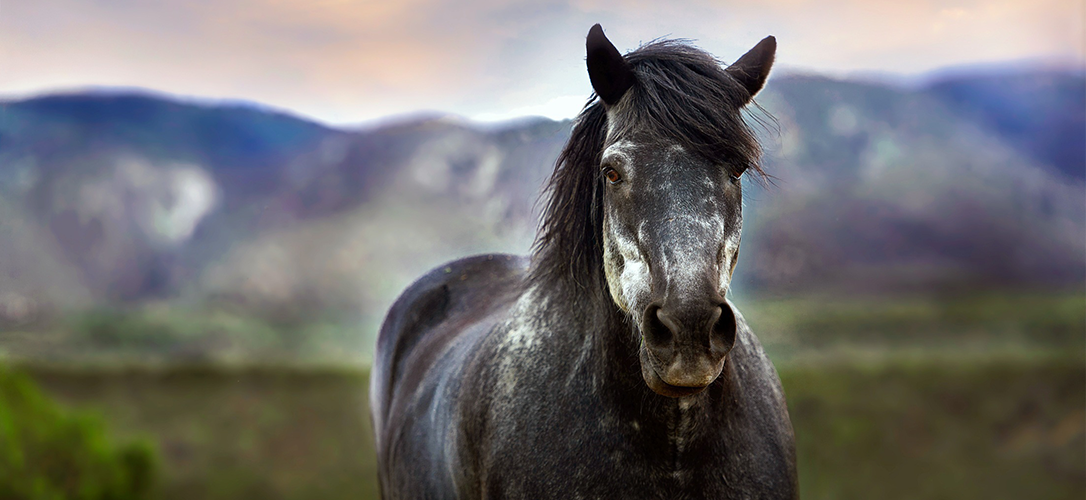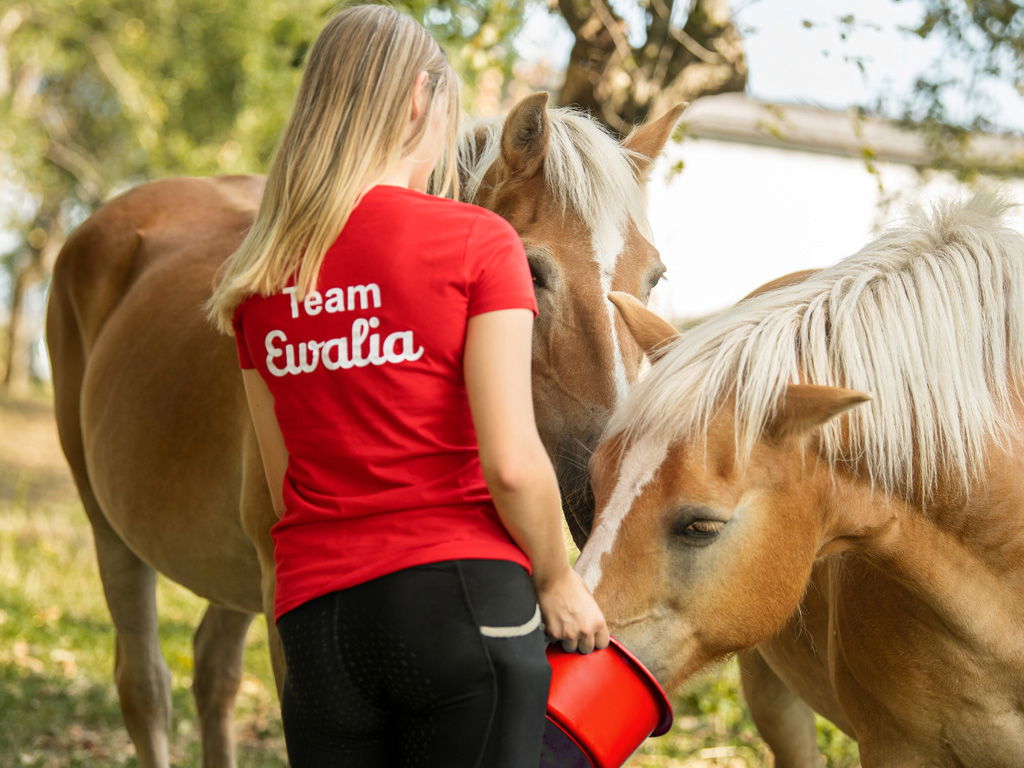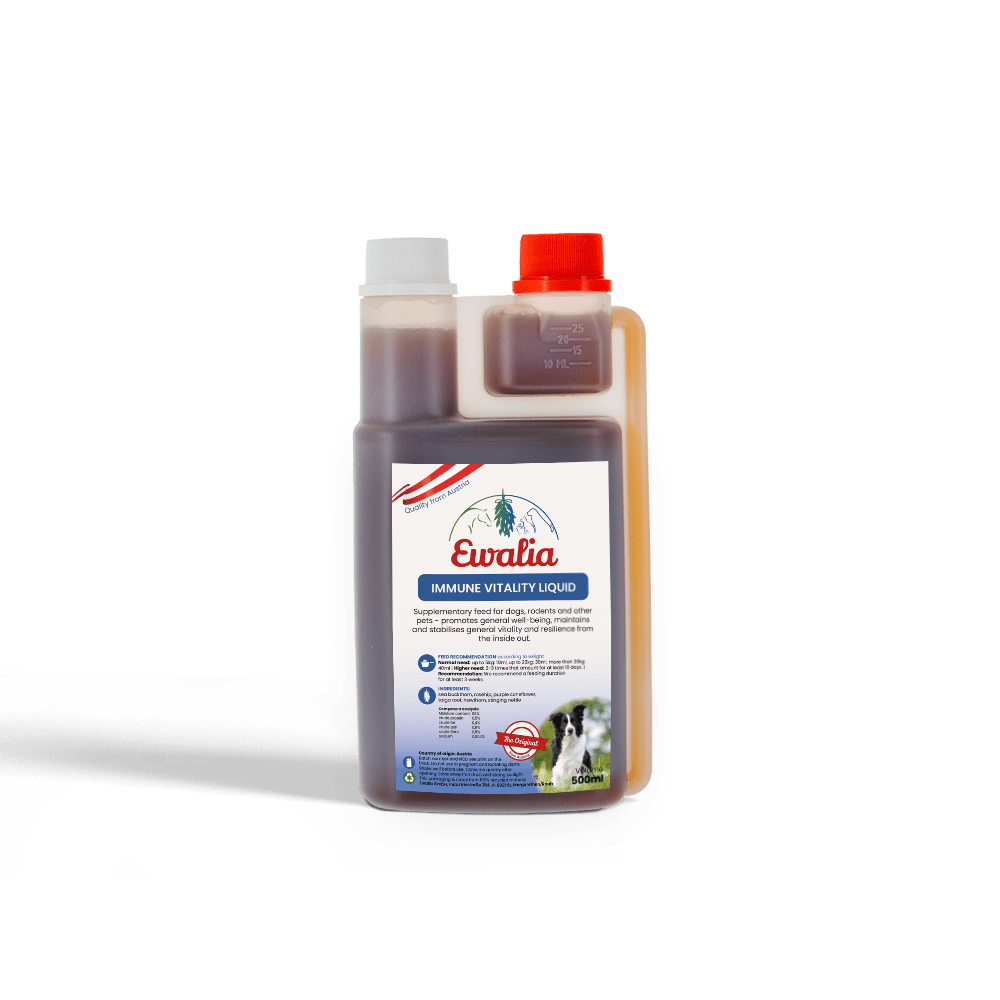The immune system of the horse

Mud fever, sweet itch, equine sarcoids and many other disease profiles are signs of a weakened or overactive immune system in a horse. In this context, people talk about immunoglobulins, immune defence, antigens and antibodies, but how does the immune system really work and, above all, how can we as people support the immune system of our horses?
What does the immune system look like?
The immune system is a network of organs, cells, proteins and sugar compounds that share the goal of protecting and healing the body from infections and diseases. To reach this goal, it has to do the following things: Disease triggers such as bacte-ria, viruses, fungi, parasites, so-called pathogens, must be detected, killed or re-moved, or ideally prevented from entering the body. The number of antibodies must be increased and multiplied and antigens that have already been fought must be stored in a directory to allow quick detection and counteraction at the next contact. Damaged tissue must be detected and repaired. Not only does all of this sound very intricate, but they are in fact complex, multifunctional biochemical processes. Where do these processes take place? Where exactly is this immune system?
The immune defence cells (immunoglobulins, acute phase proteins) themselves are constantly active and migrate through the bloodstream or form part of the blood. However, antibodies can be found in different locations such as the bone marrow, the spleen, the lymphatic system (thymus, any lymph nodes) and in different tissues such as the intestine, lungs, gastrointestinal mucous membranes. Immune cells are predominantly produced in the bone marrow, but in some cases they are not yet completely differentiated and activated. In the already mentioned lymphatic system, some of the cells complete their differentiation and are activated on the spot when they encounter antigens.
What are antigens and what are antibodies?
To put it simply: these two terms are similar to a key-and-lock principle. By definition antigens are substances that can trigger an immune reaction in a foreign organism. Among other things, they lead to the formation of antibodies. These antibodies are designed specifically to react with the structures of the invading antigens.
What does my horse need antibodies for?
For example, if anatomical barriers such as the epithelial cells of the skin and tissue do not prevent the entry of pathogens or toxins, or the physiological defences such as tears, bleeding, gastric acid, i.e. secretions, fail, antigens invade the horse's body and ideally trigger an immune response. The leukocytes (white blood cells) circulating in the blood are the most important cells of the immune system. They are further divided into other units such as neutrophilic granulocytes (non-specific de-fence predominantly in pus), eosinophilic granulocytes (defence against parasites), basophilic granulocytes (histamine, heparin, serotonin), monocytes / macrophages (that phagocytise or eat their "victims"), mast cells (trigger anaphylactic reactions in allergies), B-lymphocytes (acquired immune response, after stimulation of the path-ogens to stimulate antibody production) and T-lymphocytes (matured in the thymus, helper T-cells because they help B-cells in reproduction, memory cells). You can see that the immune system consists of many complex biochemical processes that have been extensively researched in medicine and veterinary medicine.
If a pathogen (or let's call it a foreign cell structure) enters the organism, the goal is for the matching B lymphocytes to multiply, differentiate and produce antibodies. These are also called immunoglobulins (Ig).
Which immunoglobulin is involved where?
Every antibody is matched with an antigen that consists of glycoproteins and re-sembles a Y in structure. In horses, they are well-researched due to their use in im-mune serum production. They include IgD, IgA, IgM, IgE and IgG (7 subclasses). IgA is mainly found in bodily fluids such as saliva, intestinal secretions, milk and mucous membranes. IgM activates the complement system (non-specific, innate immune system) in the early stages of the immune response. IgE is for the most part bound to membrane receptors of mast cells and basophilic granulocytes. If it binds to allergens, it causes the mast cells to release histamine and other inflammatory mediators. In the case of sweet itch, for example, this leads to a hypersensitivity re-action of the immune system. IgD is responsible for activating the B lymphocytes. IgG with its 7 subclasses accounts for the major part (80%) of immunoglobulins in the blood and is effective against viruses and bacteria and parasites
What does it mean if the immune response goes awry?
A well-functioning immune system is associated with a good balance between acti-vating and inhibiting processes. If an immune response does not proceed correctly, either no activation (immuno-suppression) or a hypersensitivity reaction (autoim-munity) is initiated upon contact with the foreign structure. According to Gerber / Straub, hypersensitivity reactions are classified into 4 different types, of which the most well-known for us horse owners is the immediate reaction (type 1) which mani-fests above all in sweet itch as a clinical picture. In the absence of an immune reac-tion, the pathogens can multiply and spread without restriction. Apart from their ge-netic cause, autoimmune diseases are often caused by the fact that the immuno-globulins (colostrum) are not transmitted through the milk of the mother mare, which often has serious consequences for the foal. Chronic respiratory diseases, chronic bacterial infections and mycoses (fungal diseases) also suggest acquired immune deficiency. Researchers in veterinary medicine in the field of immunology even see a link between sex hormones and autoimmune diseases.
How can I recognise a weakened immune system?
One can generally assume that injuries and wounds put a heavy strain on the im-mune system; on the one hand by combating the entering pathogen, on the other hand in the haemostasis and wound healing (repair of the tissue). The immune de-fence cells do their jobs until they can no longer destroy or reduce the too high number of pathogens. The immune response is too weak, pus lesions develop, fol-lowed by swelling, water retention etc. Thus, one can assume that in injuries, opera-tions, or chronic inflammation, the immune system is occupied or weakened and that it needs to be supported.
Animals with metabolic diseases almost always have a weakened immune system, as it is an active metabolism that forms the basis for fast communication among cells themselves or between cells and organs. If this communication is disturbed, the result is either a strongly delayed immune response or even an exaggerated response, since because of the inert metabolism false information is transmitted to the defence mechanisms (see above hypersensitivity reaction).
Conditions that are typically associated with weakened immune systems mostly manifest through the skin, such as sweet itch, viral diseases (e.g. sarcoids), bacteri-al infections (e.g. staphylococci), fungal infections (e.g. horse lichen), as well as parasite infestations like worms or mites. If there are sudden major changes in your horse's appearance, you can assume that it's due to a weakened immune system that needs support.
How can I support the immune system?
In severe infections, it is essential and strongly recommended that you consult your veterinarian! However, there are many factors that we horse owners can control and that have a major impact on immune function.
Horse-friendly and needs-based feeding:
High hay quality for one ensures that bacteria, molds and the like remain within ac-ceptable limits and the immune system is thus not too heavily burdened. On the other hand, careful production and storage is more likely to ensure the preservation of minerals and vitamins than unfavourable conditions.
Don't burden the digestion and the intestine with too many additional components or oversize concentrate portions, as some immune defence processes take place in the gastric acid and mucosa and the intestinal secretions. Rather feed smaller por-tions throughout the day. Remedial action in the gastrointestinal tract would also affect immune reactions.
Horses with metabolic diseases such as EMS have a weakened immune system precisely because of the disease. The cell toxins that are formed destroy or prevent the construction of cells in the body, and should be removed with a metabolic and detoxification cure as a matter of urgency. Overweight and deficient minerals and vitamins pave the way for a sluggish metabolism and thus a weakened immune system. Training, muscle building and adapting the supply of nutrients will help.
Stress-free environment and lots of exercise in the fresh air
Stress in the herd, frequent stable changes or herd changes put increased pressure on the immune system and thus on the health of the horse. A lack of exercise or standing in the stable for too long in winter, with little fresh air supply, and riding in halls with increased dust pollution increase susceptibility to respiratory tract infec-tions.
After surgery and severe injuries, it is recommended that the horse not be exposed to high levels of immune pressure and weather (stable rest, quarantine box), so that there is sufficient energy available for metabolism and convalescence. Short walks (if possible and allowed during rehabilitation) are good for the lungs as well as the mind and provide variety.
A balanced supply of vitamins, mineral, trace elements and amino acids
It would be ideal to ensure a balanced supply, adapted to the horse's needs and the roughage available, of all the essential minerals, vitamin and trace elements. Zinc, Vitamin C+B+K strengthen the immune system and assist in internal cell pro-tection. Essential amino acids are not only responsible for the proliferation of mus-cle cell, but are also involved in the construction of immune system cells.
Ewalia Immune liquid with herb profiles
Our immune liquid contains water, rosehip, echinacea, liquorice root, fennel, gen-tian, hawthorn, nettle and lemon balm. It is a highly concentrated herbal extract that contains neither preservatives nor added sugar or other chemical additives and is therefore suitable for horses with metabolic diseases. Below you can see the pro-files of the individual herbs that make up the mixture.
Rosehip
Special ingredients:
Rosehip contains a lot of vitamin C, other vitamins (A, B1, B2, K, P), minerals, fruit acids, flavonoids, tannins, etc.
Efficacy and areas of application:
Primarily antioxidant, anti-inflammatory and improves blood fat levels (clinically confirmed). A moderate effect on osteoarthritis is also clinically documented.
It increases the body's defences and is used in the treatment of colds and influenza infections. Vitamin C strengthens the formation of the building blocks of the immune system. Vitamin C is used up very quickly during fever and colds, and also with wound healing.
Echinaceae purpureae (purple coneflower)
Special ingredients:
Echinacin, Echinacosid
Efficacy and application:
Handed down by the prehistoric population of the Americas, this plants if used for all types of wound healing. In the 20th century it became known that certain com-pounds in echinacea initiate biochemical processes against bacteria and even vi-ruses. Other active ingredients of echinacea increase the body's defences and in human medicine are recommended as support during chemotherapy. It is one of the classic cold remedies.
Liquorice (liquorice root)
Special ingredients:
The main component is glycyrrhizin, a mixture of potassium and calcium salts of glycyrrhizic acid (50x sweeter than cane sugar).
Efficacy and areas of application:
Glycyrrhizin has a strong anti-inflammatory, antiviral and antimicrobial effect, and temporarily increases the half-life of cortisol and aldosterone. An antiulcerogenic effect (reduction of gastric acid), especially after prolonged administration of anal-gesia, was demonstrated in experiments. In general use, liquorice root is said to have an anti-emetic, anti-inflammatory and antispasmodic effect and is used against cough, gastritis and gastric ulcers.
Fennel
Special ingredients:
Essential oil (trans-anethole, fenchone, estragole, etc.). A distinction is made be-tween bitter or sweet fennel, with a slight difference between the ingredients in con-centration.
The active ingredient in fennel is the essential oil. 50-70% of it consists of the sweet-tasting trans-anethole and fenchone, which tastes like camphor, and other substances. It is very similar to aniseed oil
Efficacy and areas of application:
The proven spectrum of action ranges from antimicrobial and spasmolytic, through secretolytic (production of mucus) and expectorant to anti-inflammatory. In folk med-icine it is used for convulsive gastrointestinal complaints, menstrual cramps, as an expectorant cough medicine, for calming and as a carminative (for flatulence).
Gentian
Special ingredients:
Bitter substances, mainly gentiopicrin and the recently discovered bittern ama-rogentin, with the highest bittern levels, low tannins and essential oil.
Efficacy and areas of application:
Gentian root is a pure bittern drug. The other ingredients are of secondary im-portance. The tannin content is low, which is very important when using it as a stomach tonic, as any undesirable irritant effects are thus eliminated. Loss of appe-tite, a weak stomach with lack of gastric juice secretion, disorders of the emptying process of the stomach, flatulence as well as gastric and intestinal cramping and slackness states can be successfully treated with gentian tea. Gastric acid produc-tion is boosted. The bitter substances act through contact with the mucous mem-branes in the mouth, where they trigger healing reflexes, and also after being ab-sorbed in the body of the horse. The bitterns it contains make it one of the oldest remedies, and has been handed down since the time of Hippocrates (5th century before Christ).
Hawthorn
Special ingredients:
The positive crataegus effect is unleashed only through the interaction of all the ac-tive ingredients and leads to exponential efficacy. The active ingredients predomi-nantly flavonoids, oligomeric prycyanidines, biogenic amines and others.
Efficacy and areas of application:
Hawthorn is an excellent cardiac remedy and can be used for a wide range of car-diovascular disorders. Taking it on a permanent basis is harmless and in most hu-man cases necessary. Hawthorn is a good support option, even as a precaution against increased stress, as it improves the overall cardiac performance, like coro-nary circulation, and calms even "nervous" hearts.
Stinging nettle
Special ingredients:
1-2% flavonoids, 1-4% (at times water-soluble) silicates, scopoletin and sitosterol, caffeic acid esters, polyphenols, proteins, fat, carbohydrates and vitamin K.
Efficacy and areas of application:
The main effect of nettle leaves is to increase urination and excretion and thus to stimulate the metabolism. In human medicine it is used to alleviate prostate problems in men.
Lemon balm
Special ingredients:
The most important ingredient is the essential lemon balm oil with citronellal, citral and caryophyllene. The minerals, the tannins and bitter substances and small amounts of flavonoids must also be mentioned.
Efficacy and areas of application:
The most important aspect of lemon balm is its calming effect. It counteracts nerv-ousness due to overstimulation, calms the stomach (spasmolytic, carminative effect) and the mind and boosts the body's defences.
Proven effects in experiments: antiviral against herpes simplex, influenza and myx-oviruses. The watery melissa extract (actually rosmarinic acid) inhibits virus adsorp-tion and prevents the virus from entering the cell. A light sedative and antiulcer-ogenic (promoting gastric mucous) effect has also been confirmed.
Gerber V./ Straub R. (2016): Equine diseases. Internal medicine. 2nd edition. utb Haupt Verlag, Bern.
Julia. M./ Felippe B. (2016): Equine Clinical Immunology. 1st edition. Wiley-Blackwell Publishers, Oxford.
Pahlow, M. (2017): The big book of medicinal plants. Healthy through the healing powers of nature. 6th edition, Nikol Verlagsgesellschaft mbH, Hamburg.
Blaschek, W. (2015): Gnome teas and phytopharmaceuticals. A practical guide. 6th edition, Wissenschaftliche Verlagsgesellschaft, Stuttgart.















